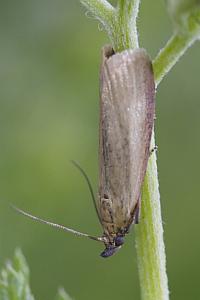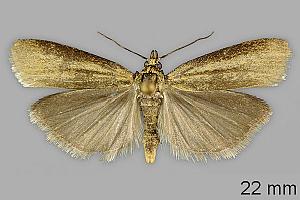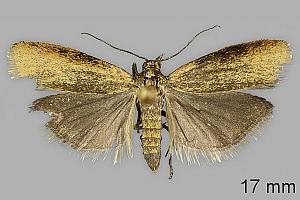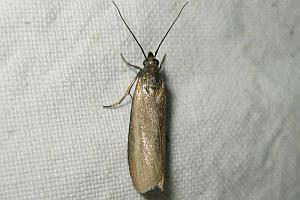2. Diagnose
2.1. Männchen
2.2. Weibchen
2.3. Geschlecht nicht bestimmt
4. Weitere Informationen
4.1. Etymologie (Namenserklärung)
Jalava (1978: 317): “Derivation of name: lucipetella (adjective) means attracted to light.”
4.2. Andere Kombinationen
- Nephopterix lucipetella Jalava, 1978 [Originalkombination]
4.3. Faunistik
Yepishin et al. (2020: 116) melden den Erstnachweis für die Ukraine und fassen zussammen: "S Finland, Estonia, Latvia, Denmark (Slamka 2019); Russia: N and C of European part, S Urals, S of W Siberia (Sinev et al. 2019); first record for Ukraine: Chernihiv region."
4.4. Typenmaterial
Jalava (1978: 317): “Holotype: 1 ♂ labelled: “Finland, Ka, 671:53, Virolahti, 17.7.1974, J. Jalava leg.” (white label) – “Gen. prep. n:o 416 J. Jalava” (white label) [Genitalia mounted on slide] – “Holotypus” (red label) – “Mus. Zool. H:fors Spec. typ. No 12476 Nephoterix [fehlendes p: Druckfehler?] lucipetella Jalava” (blue label), in coll. Zool. Mus. Helsinki.” — Paratypen: 6 ♂♂, alle aus Finnland.
4.5. Literatur
- Erstbeschreibung: Jalava, J. (1978): Nephopterix lucipetella n.sp. from southern Finland (Lepidoptera: Pyralidae). — Entomologica Scandinavica 9 (4): 317-318 [Abstract auf ingentaconnect.com].
- Yepishin, J., Bidzilya, O., Budashkin, Yu., Zhakov, O., Mushynskyi, V. & S. Novytskyi (2020): New records of little known pyraloid moths (Lepidoptera: Pyraloidea) from Ukraine. — Zootaxa 4808 (1): 101-120.




![Vorkommen in Dänemark (außer Färöer-Inseln und Grönland) [Aarvik & al. (2017): Nordic-Baltic Checklist]](/res/img/flag/dk.gif)
![Vorkommen in Finnland (außer Åland-Inseln) [Aarvik & al. (2017): Nordic-Baltic Checklist]](/res/img/flag/fi.gif)
![Vorkommen in Russland (europäischer Teil bis Manytsch-Niederung) [Sinev (2021)]](/res/img/flag/ru.gif)
![Vorkommen in der Ukraine (ohne Halbinsel Krim) [Yepishin, Bidzilya, Budashkin, Zhakov, Mushynskyi & Novytskyi (2020)]](/res/img/flag/ua.gif)
![Vorkommen in Estland [Aarvik & al. (2017): Nordic-Baltic Checklist]](/res/img/flag/ee.gif)
![Vorkommen in Lettland [Aarvik & al. (2017): Nordic-Baltic Checklist]](/res/img/flag/lv.gif)
![Vorkommen in Litauen [Ivinskis, & Rimšaitė (2022)]](/res/img/flag/lt.gif)





